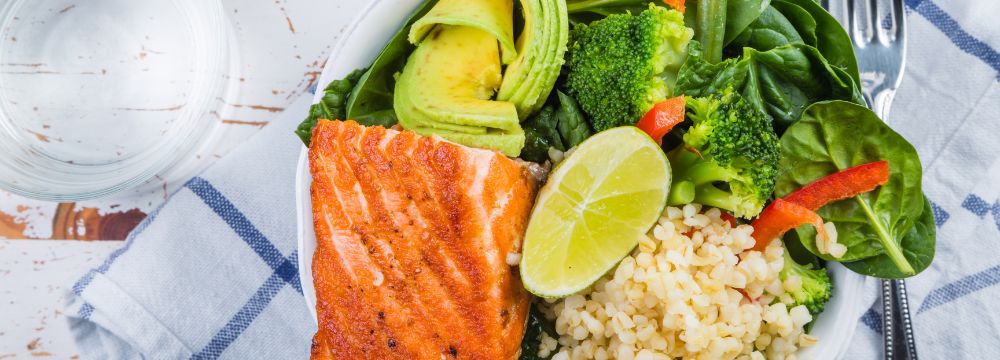Macronutrients

Macronutrients are essential nutrients our body requires in large quantities to be healthy. The term comes from the Greek word “macro,” which means large, and the Latin word “nutriens,” which means feed, support, and preserve. Macronutrients are often referred to as simply “Macros.”
There are three main macronutrients: carbohydrates, protein, and lipids. Some people consider water a macronutrient since it is so essential for our health, and we need it in large amounts. Most foods contain a combination of more than one type of macronutrient. However, for practical reasons, we often tend to categorize a food item based on the macronutrient in the most significant amount.
Carbohydrates
Carbohydrates are often referred to as carbs and can be divided into three types: sugar, starches, and fiber. Our body breaks carbohydrates down into glucose, our primary energy source for cells, tissues, and organs.
Based on their chemical structure, carbohydrates can be divided into simple or complex. Simple carbs (sugars) are characteristic of being digested and absorbed more quickly than complex carbs (starches and fiber). Simple carbs, therefore, often lead to a rapid increase in blood glucose levels.
Fruit and dairy products are examples of foods naturally rich in simple carbs. However, most of the simple carbs we eat are added to foods like sugar, corn syrup, high-fructose corn syrup, glucose, fructose, sucrose, or fruit juice concentrates.
Foods rich in complex carbs (starches and fiber) are, for example, grain products (whole wheat bread, pasta, breakfast cereals), rice, potatoes, beans, nuts, oats, and corn.
Complex carbs are lower on the glycemic index, which means a slower and steadier increase in blood glucose levels – avoiding the spikes and troughs of simple carbs. For this reason, complex carbs are essential in helping maintain a healthy body weight and preventing type 2 diabetes and cardiovascular conditions.
Proteins
Proteins are molecules essential for the structure, function, and regulations of our cells, tissues, and organs. This macronutrient can be found throughout our body, skin, hair, muscles, bones, blood, and various organs. Many proteins act as enzymes in the numerous biochemical reactions necessary for life. Proteins are also essential for our body’s production of hormones.
These large size molecules are polymers of smaller units called amino acids. There are 20 types of amino acids, which by linking together in various combinations and structures, create different types of protein. Our body requires all 20 amino acids in the correct amounts but can produce only 11. The remaining nine are essential since they must be introduced through food or supplements. These amino acids are histidine, isoleucine, leucine, lysine, methionine, phenylalanine, threonine, tryptophan, and valine.
Protein-rich foods are meat, eggs, poultry, fish and seafood, dairy products, soy products, seeds, nuts, and beans. Plant proteins (beans, nuts, seeds, and whole grains) usually lack at least one essential amino acid and are considered “incomplete proteins.” Exceptions include soybeans and quinoa which contain all nine essential amino acids. Eating various protein sources makes it possible to obtain a healthy amount of all essential amino acids.
This illustrates how not all proteins are the same.
Lipids
Lipids also referred to as fats, are essential to our body for energy storage and many critical functions such as hormone production, nutrient absorption, and maintenance of body temperature. Fats also have an important structural role in the cell membranes, particularly in the brain and nervous system.
Fats are found in food mainly in the form of triglycerides and cholesterol. Triglycerides are composed of fatty acids. Fatty acids come in many different configurations, creating their unique chemical and physical properties. We can differentiate between saturated and unsaturated fatty acids based on the other structures. Saturated fatty acids are long, straight, tightly linked molecules commonly found in solid fat deposits in animal products, such as meat and dairy products. Unsaturated fatty acids are characterized by a looser structure, which allows them to remain in liquid form. These fatty acids are found primarily in seed oils and fish.
Though fatty acids are easily obtained through food, our body can produce all types except for two, referred to as essential fatty acids. These two fatty acids are alpha-linolenic acid (an omega-three fatty acid) and linoleic acid (an omega-six fatty acid) and must be obtained through our diet. Good food sources of essential omega-3 fatty acids are fish and seafood (cold-water fish such as salmon, mackerel, tuna, herring, and sardines) and nuts and seeds (such as walnuts, chia seeds, and flaxseed). Essential omega-6 fatty acids can be found in nuts, seeds, eggs, and vegetable oils.
Macronutrients and Calories
While each type of macronutrient has particular characteristics and plays a unique and essential role in our health, all macros contain and provide energy to our body in the form of calories. Carbs are our primary energy source, but our body can also produce energy from fats and protein.
All carbs and proteins contain four calories per gram, while fats have nine calories per gram. The composition of each food product’s carbs, protein, and fats determine the number of calories the food contains and provides to our body.
